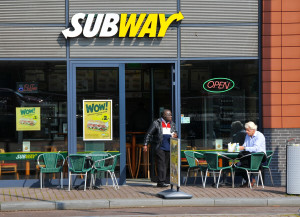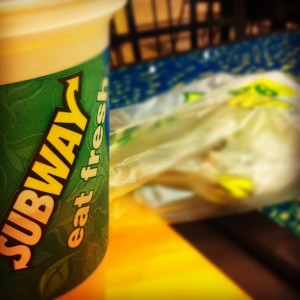Sandwiches and Scandal
Posted on September 24, 2015, at 9:00 a.m.
by Katie Gatti.
Do you know what the largest fast food chain in the world is? If you’re thinking McDonald’s, think again. Subway, the 50-year-old sandwich chain, has nearly 10,000 more locations worldwide than the iconic golden arches.
Subway weighs in with a modest 44,222 locations. Such a massive arsenal of sub shops may suggest prosperity, but its earnings indicate otherwise: its $475,000 per-store profits were the second-worst in the most recent QSR 50 report.
It’s no surprise, then, that ex-spokesman Jared Fogle’s July media storm came as an unfortunate blow to the already stagnant brand. The exposure of Fogle’s sexually inappropriate past involving minors came as an ironic plot twist in the midst of Subway’s developing campaign: prior to the FBI raid, Subway had plans to rebrand Fogle as a happy family man with a healthy lifestyle (the implication being, of course, that eating a steady diet of Subway sandwiches helped deliver Fogle to his slimmed down state of marital bliss).
Scandal and severance

Subway reacted quickly to the news of Fogle’s reported plea bargain with the U.S. Attorney’s Office, releasing a statement severing 15-year ties with Fogle only a few hours after the deal went public. A curt tweet merely announced, “We no longer have a relationship with Jared and have no further comment.”
“Do not offer more than you know to be fact but be sure you are ready to respond when needed,” advises Mary Barber, president of The Barber Group, a strategic communication and public relations firm in Gig Harbor, Washington. “Honesty and transparency are the two most critical items in any crisis. Get ahead of the crisis by communicating your position and expressing your concern and sorrow.”
In response to the dire circumstances, Subway’s marketing team quickly developed an exit strategy. Its veteran marketing chief, Tony Pace, is scheduled to step down Sept. 30, and its vice president of media services, Karie Ford, is planning her own departure soon after.
While Subway was quick to renounce its partnership with Jared, the brand was not scrubbed of its affiliation as quickly as it should have been. A feature remained on Subway’s website for days after the plea bargain, entitled “Jared’s Pants Dance”: a game that literally allowed children to play with Jared’s pants.
“[Jared] was a spokesperson, and what happened to Subway is emblematic of the risks that any brand runs with longtime spokespeople,” said Greg Brooks, principal of West Third Group, a strategic communication and integrated marketing firm in Phoenix, Arizona. “Subway distanced itself quickly and efficiently, and I guarantee the brand is under much more pressure from changing consumer tastes and eroding market position than they are because of Jared.”
Unfortunately, the disclosure of Fogle’s sinister side wasn’t the only Subway-related disgrace in recent years: It endured criticism last year when a chemical found in yoga mats was also discovered in its bread.
The child pornography scandal merely called more immediate public attention to Subway’s outdated marketing and slumping sales. So what is Subway’s next move now that Fogle has faltered from a sweater-clad dad to a sexual predator?
Fogle’s fat pants and the “Subway diet”
Subway’s relationship with Fogle began in 1999, less than a year after the 425-pound man announced he would eat only two Subway sandwiches a day in an effort to lose weight.
In less than a year, Fogle had shed an unbelievable 245 pounds on what became famously known as the “Subway diet.” His unusual strategy garnered media coverage, and Subway caught wind of his transformation. Fogle was asked to do a commercial, and in 2000, a star was born.
Only eight years later, Advertising Age reported that Subway’s sales had doubled since the dawn of Fogle’s representation.
Fast-forward to the health push of the early 2000s, and suddenly consumers have options that allow them to eat “fresher” than Subway. Among Subway’s younger, more agile contenders are Chipotle, Jimmy John’s and Firehouse Subs.
The evolution of “fresh”
According to the New York Post, the sinking chain has been “hurt by changing consumer tastes.” When Subway hit the fast food scene in 1965, its image as a healthy alternative to burgers and fries catapulted it one step ahead of its greasy competitors.

The New York Post reports that Subway has plans for a major rebranding in mid-2016, but an examination of Subway’s strictly negative recent media coverage intimates that perhaps this brand turnover is years overdue.
“Brands need to constantly evolve and change to stay relevant to what customers want. Not doing so can spell big-time trouble,” Barber said of Subway’s lagging brand awareness.
For example, Chipotle’s 2015 announcement to use only non-genetically modified organisms in its food starkly contrasted the chain to Subway, which still uses meat that’s not antibiotic-free — a switch that should’ve been made years ago when consumers began demanding products boasting the “organic” or “all-natural” labels.
When it comes to restaurants that offer nearly the same product at a comparable price (like Jimmy John’s or Firehouse Subs), Subway must directly compete. It is in this realm of sandwich rivalry that strategic marketing and positive public relations can make or break a chain.
“A brand is the most pivotal thing to a company’s success, but too many companies are slogging through mud in the marketplace because, despite their nice logos and tag lines, they don’t really have a brand,” Brooks said. “A brand is a representation of a promise, and that promise, executed correctly, says: ‘We understand and will deliver on your expectation of value.’”
A chance for change
Antibiotic-free chicken is among Subway’s anticipated 2016 changes. Other upgrades include updated store designs, revamped employee uniforms and new menu items that will attempt to compete in the ever-growing “healthy” fast food market.
Luckily, coming back from unpleasant media coverage isn’t as difficult as it may seem. “From Hertz with OJ Simpson to Kellogg and AT&T with Michael Phelps, the evidence is far more compelling that a bad spokesperson doesn’t bring down (or even slow down) a brand that’s quick to cut ties when things get rocky,” Brooks said.
Barber’s take on Subway’s rebranding has very little to do with Fogle’s blunder: “I don’t think they need to mention the Jared issue again, but should instead look at the rebranding that makes the most sense for the company. Since Jared took a plea deal, the whole thing is likely over. They should pick up the pieces, rebrand and move on.”





